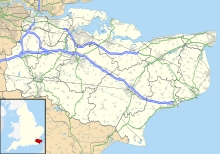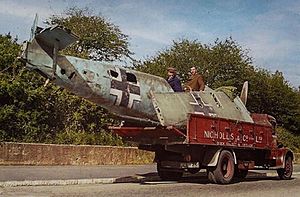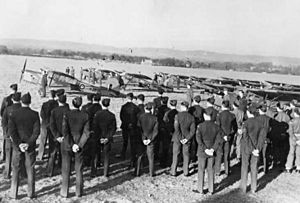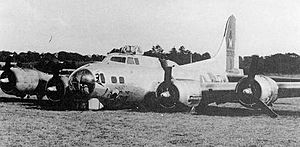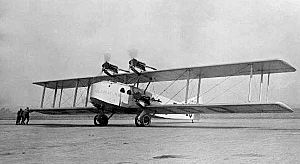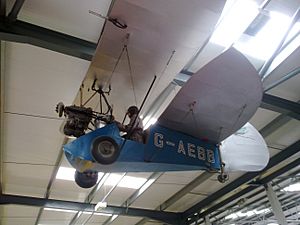Penshurst Airfield facts for kids
Quick facts for kids
Penshurst Airfield
RAF Penshurst
|
|||||||||||
|---|---|---|---|---|---|---|---|---|---|---|---|
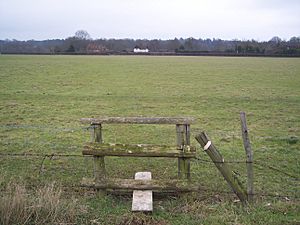
The site of Penshurst Airfield, February 2010
|
|||||||||||
| Summary | |||||||||||
| Airport type | Closed | ||||||||||
| Serves | Penshurst, Kent | ||||||||||
| Location | Leigh, Kent | ||||||||||
| Built | 1916 | ||||||||||
| In use | 1916–1936 1940–1946 |
||||||||||
| Occupants | 2 Wireless School RFC 268 Squadron RAF 653 Squadron RAF 661 Squadron RAF 664 Squadron RAF |
||||||||||
| Elevation AMSL | 177 ft / 54 m | ||||||||||
| Coordinates | 51°12′N 0°11′E / 51.200°N 0.183°E | ||||||||||
| Map | |||||||||||
| Runway | |||||||||||
|
|||||||||||
Penshurst Airfield was an important airfield in Kent, England. It was open for two main periods: first from 1916 to 1936, and then again from 1940 to 1946.
At first, it was a military airfield. After the First World War, it became a backup airport for Croydon Airport. This meant some civilian planes used it. The airfield closed in 1936 after a small plane called a Flying Flea crashed during an air show. The land was then turned into a polo field.
During the Second World War, it reopened as an emergency landing spot for planes, known as RAF Penshurst. It was mostly used by special Air Observation Post (AOP) squadrons of the Royal Air Force. These squadrons helped spot things from the air. Penshurst Airfield finally closed for good in May 1946.
Contents
Where was Penshurst Airfield?
The airfield was located south of Charcott, near the villages of Leigh and Chiddingstone. Its exact spot was 51°12′N 0°11′E / 51.200°N 0.183°E.
Even though it was near Leigh and Chiddingstone, it was named Penshurst. This was because Penshurst was seen as a more well-known and "up-market" name. The airfield was about 2 miles (3.2 km) north of Penshurst village. The nearby Penshurst railway station is actually in the parish of Chiddingstone.
A Brief History of the Airfield
Early Days: 1910s
Penshurst Airfield first opened in December 1916 during the First World War. It had a grass runway and covered about 72 acres (29 hectares). The runway was 2,000 feet (610 meters) long and ran east to west.
There were two large hangars for planes. A big house nearby, Knotley Hall, was used as a place for the officers to live. In 1917, Royal Aircraft Factory B.E.12 planes from No. 78 Squadron RFC were based here.
On November 8, 1917, No. 2 Wireless School started at Penshurst. This school taught aircrew how to use wireless radios in planes. They used different types of aircraft like the Airco DH.6 and Avro 504. The school closed on March 23, 1919. By September 1919, the airfield was no longer needed by the Royal Air Force. It was then suggested as an emergency landing spot for civilian planes.
Civilian Use: 1920s
In February 1920, pilots were told that if they had to land at Penshurst in an emergency, they could use a special telephone to call the police. This would help them get a ride to Penshurst station.
On June 5, 1920, the first airmail flight from the Netherlands to the United Kingdom happened. The pilot, Bert Hinchcliffe, was flying from Amsterdam to Croydon Airport. But bad weather and low fuel forced him to land at Penshurst. He then took a taxi to London with the letters.
A large fabric windsock was put up in November 1920 to show wind direction. In September 1921, a de Havilland DH.18 plane had to land at Penshurst because Croydon Airport was too foggy.
From 1922, the airfield had a special illuminated "T" shape to help pilots land at night. It also had colored lights that changed with wind strength: green for no wind, white for moderate wind, and red for strong wind.
On June 10, 1922, famous pilot Alan Cobham landed at Penshurst. He was flying from Belgrade, Yugoslavia, with photos of a royal wedding for the Daily Mirror newspaper. He had to land because of bad weather. The photos were taken to London by road.
In 1925, runway lights were added. In 1927, the Tunbridge Wells Air Pageant was held at Penshurst. This event was to promote a new flying club.
The 1930s and Closure
In 1930, a company called Home Counties Aircraft Services was based at Penshurst. They even showed a de Havilland DH.60 Moth plane in a car showroom in Tunbridge Wells, which caused a lot of excitement!
Penshurst was often used as a backup airport for Imperial Airways when Croydon Airport was too foggy. However, it didn't have Customs facilities, which caused delays for passengers. Later, a Customs Officer started coming daily, but this stopped in 1935.
On July 22, 1936, Charles Lindbergh, a very famous pilot, flew from Penshurst to Berlin. He was invited by Hermann Göring, a top German official.
Penshurst Airfield closed on July 28, 1936, because its land lease ran out. The company operating it, Air Travel Ltd, moved to another airport. In 1938, the land was turned into a Polo ground.
Reopening for World War II: From 1940
In 1940, during the Second World War, the Royal Air Force took over the airfield again. They built Nissen huts and cleared the area to use it as an Emergency Landing Ground. Three small concrete bunkers called pillboxes were built around the airfield for defense.
During the famous Battle of Britain on October 27, 1940, a German Messerschmitt Bf 109E plane crash-landed at RAF Penshurst. The pilot, Fw Lothar Schieverhofer, had been in a dogfight with a British Supermarine Spitfire. The Spitfire pilot, Plt Off Peter Chesters, also landed at Penshurst because he was low on fuel. A small fight broke out between the two pilots before others arrived to stop it. The German pilot was taken away as a prisoner of war.
Different RAF squadrons used Penshurst during the war. No. 268 Squadron RAF used Curtiss Tomahawk planes here in 1941. Later, No. 653 Squadron RAF and No. 661 Squadron RAF used small Auster planes. These Austers were used for "Air Observation Post" duties, helping to spot enemy positions and direct artillery fire.
On July 6, 1944, a large American Boeing B-17 Flying Fortress bomber, named The Prowler, made an emergency landing at RAF Penshurst. It was returning from a bombing mission in France. Most of the crew parachuted out before it landed. The plane was badly damaged.
In February 1945, No. 664 Squadron RAF also flew Austers from Penshurst before moving to the Netherlands. RAF Penshurst finally closed on May 13, 1946. The old control tower was taken down in the 1970s, and a hangar blew down in a storm in 1991.
Plane Accidents at Penshurst
- On August 20, 1922, a plane flown by Thomas Baden Powell crashed while landing at Penshurst. He was later fined for flying a plane that wasn't registered and for not having a valid pilot's license.
- On October 2, 1926, a Blériot 155 plane named Clement Ader crashed near Leigh. There was a fire on board, and all seven people died. The pilot was trying to make an emergency landing at Penshurst. This was the first time a fire happened on a civilian airliner during a flight.
- On May 2, 1930, a Farman F.63 Goliath plane crashed in Penshurst. It ran into a strong storm while flying from France to Croydon.
- On May 4, 1936, a small plane called a Mignet HM.14 "Flying Flea" crashed at an airshow at Penshurst. The pilot died. Because of this accident, there were calls to stop all Flying Flea planes from flying until an investigation could be done. This crash led to the airfield closing soon after.


